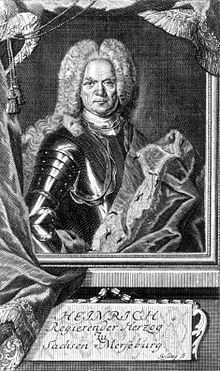Flag Coat of arms 1694 Christian III Maurice Founded 1657 | ||
 | ||
The Duchy of Saxe-Merseburg was a duchy of the Holy Roman Empire, with Merseburg as its capital. It existed from 1656/57 to 1738 and was owned by an Albertine secundogeniture of the Saxon House of Wettin.
Contents
History
The Wettin Elector John George I of Saxony stipulated in his will dated 20 July 1652 that his three younger sons should receive secundogeniture principalities. After the elector died on 8 October 1656, his sons concluded the "friend-brotherly main treaty" in the Saxon residence of Dresden on 22 April 1657 and a further treaty in 1663 delineating their territories and sovereign rights definitively. The treaties created three duchies: Saxe-Zeitz, Saxe-Weissenfels, and Saxe-Merseburg.
Prince Christian, the third oldest son, received, among other properties, the estates of the former Bishopric of Merseburg, secularised in 1565: the castles, cities and districts of Merseburg, Plagwitz, Rückmarsdorf, Delitzsch (with Delitzsch Castle), Bad Lauchstädt, Schkeuditz, Lützen, Bitterfeld, Zörbig, the County of Brehna as well as the Margraviate of Lower Lusatia, including the cities and castles of Lübben, Doberlug, Finsterwalde, Döbern, Forst and Guben. Many of these territories had belonged to the Diocese of Merseburg until it was secularized in 1562.
The area of Saxe-Merseburg stretched to the western city limits of Leipzig. The customs station was in what is now the inner city district of Lindenau.
After the death of the last male heir of the Saxon branch line in 1738, the Duchy of Saxe-Merseburg fell back to the Electorate of Saxony.
Rulers
Cadet lines
To supply his three younger sons with incomes befitting a duke, Duke Christian I created apanages for his younger sons during his lifetime. These territories remained dependent on the main line and their sovereignty was severely restricted. They were named after their owner's residences and disappeared with the death of their first duke, because none of them fathered surviving male heirs. Before it died out, the Saxe-Merseburg-Spremberg line inherited all of Saxe-Merseburg.
